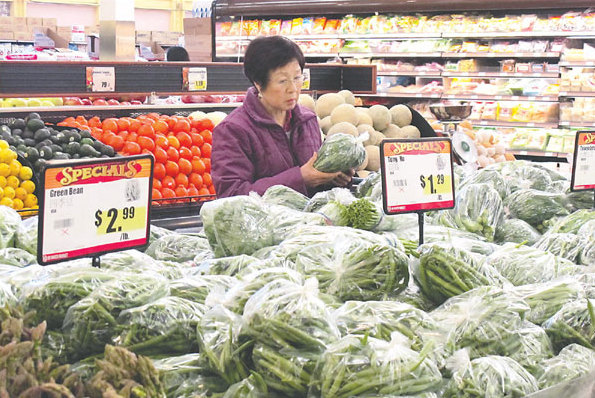Asian vegetables entice growers
Updated: 2013-03-26 10:32
By Yu Wei in San Francisco (China Daily)
|
||||||||
|
A customer selects vegetables at a Chinese supermarket in San Francisco. Yu Wei / China Daily |
When Lin Qingyan immigrated in 1980, Asian fruits and vegetables were a rare find in the United States, and the Chinese native wondered if favorites from home like bitter melon and luffa might be but a memory.
More than 30 years later, Lin can buy both of those delicacies as easily as green peppers and tomatoes in many food stores in California, where she now lives.
"There's a wide variety of Asian vegetables available now that weren't decades ago. Because of the accessibility of Chinese vegetables, there are quite a lot of dishes I missed before but can now cook myself," she said.
American farmers now grow a wide variety of produce native to China and other parts of Asia, and first-generation immigrants like Lin aren't the only consumers.
Mary Peterson, a housewife in Cupertino, California, frequently shops at 99 Ranch, a chain of Asian-American supermarkets with 35 stores in four southwestern states.
"Baby bok choy is my favorite vegetable. My Chinese friend introduced it to me and I've fallen in love with it since then," she said of the cabbage variety.
"The demand for Chinese-type vegetables has risen in recent years," said Alan Walters, a horticulturist who teaches vegetable science at Southern Illinois University.
In addition to the large number of Chinese immigrants and expatriates in the United States, tourists and short-term residents are also fueling demand. According to the Commerce Department, about 1.5 million people from the Chinese mainland visited the US in 2012. China remains the top source of international students on US campuses, with over 194,000 enrolled during the 2011-12 academic year.
Although it ranks far behind Mexico and Canada in farm exports to the US, China accounts for 5 percent of that market, supplying mushrooms, dried vegetables, water chestnuts, garlic and bamboo shoots, according to the US Department of Agriculture.
More Americans are becoming familiar with cooking Chinese dishes at home, so seeking out the necessary ingredients broadens the market beyond its niche origins, Walters said.
The quest for foods that are healthful and add variety to one's diet are other reasons for the current surge in popularity, according to a study that Walters led.
While limited research has been conducted to gauge the potential for native-Asian fruits and vegetables in the US, the professor believes the market will keep expanding.
"Although many Americans are still learning about these vegetables, they are required in Asian US markets, which are near large cities," said Walters, a member of SIU's plant soil and agricultural systems faculty.
Despite big demand in some areas, particularly major cities with sizable Chinese and Chinese-American populations, some produce still isn't reaching store shelves. That creates openings for enterprising farmers.
"Depending on a grower's location [relative] to Asian populations, there is still a great opportunity to obtain significant revenues from these crops," Walters said.
According to the USDA, there were 20,417 Asian-born operators on 15,360 farms and ranches across the country as of 2007. That year, the number of farmers of Asian heritage jumped 40 percent from 2002, significantly outpacing a 7 percent rise in US farming operators overall, the department's most recent Census of Agriculture, conducted every five years.
While Asians represent a small fraction of all farmers on US soil, their numbers are growing fast.
Richard Molinar, an adviser with the University of California's Cooperative Extension farm-outreach programs, said demand has led to increased cultivation of Asian vegetables in Fresno County, where he works. The county is in the heart of California's Central Valley, one of the most productive farming regions in the world and home to many immigrant farmers from China, Laos and Vietnam.
"We have around 50 to 75 Chinese farmers here in Fresno County and over 2,000 acres of Chinese crops selling locally as well as nationwide," Molinar said.
Organizations such as UC Cooperative Extension offer advice and services to these growers.
"In addition to providing them with technical support, we also help those farmers to find new marketing opportunities."
yuwei12@chinadailyusa.com

 In Photos: 7.0-magnitude quake hits Sichuan
In Photos: 7.0-magnitude quake hits Sichuan
 Li Na on Time cover, makes influential 100 list
Li Na on Time cover, makes influential 100 list
 FBI releases photos of 2 Boston bombings suspects
FBI releases photos of 2 Boston bombings suspects
 World's wackiest hairstyles
World's wackiest hairstyles
 Sandstorms strike Northwest China
Sandstorms strike Northwest China
 Never-seen photos of Madonna on display
Never-seen photos of Madonna on display
 H7N9 outbreak linked to waterfowl migration
H7N9 outbreak linked to waterfowl migration
 Dozens feared dead in Texas plant blast
Dozens feared dead in Texas plant blast
Most Viewed
Editor's Picks

|

|

|

|

|

|
Today's Top News
Live report: 7.0-magnitude quake hits Sichuan, heavy casualties feared
Boston suspect cornered on boat
Cross-talk artist helps to spread the word
'Green' awareness levels drop in Beijing
Palace Museum spruces up
First couple on Time's list of most influential
H7N9 flu transmission studied
Trading channels 'need to broaden'
US Weekly

|

|








